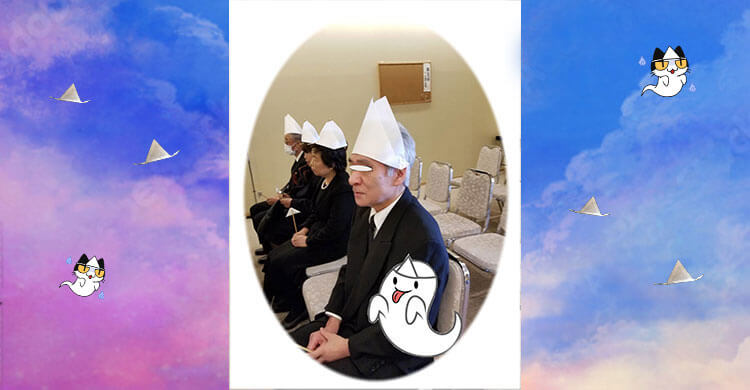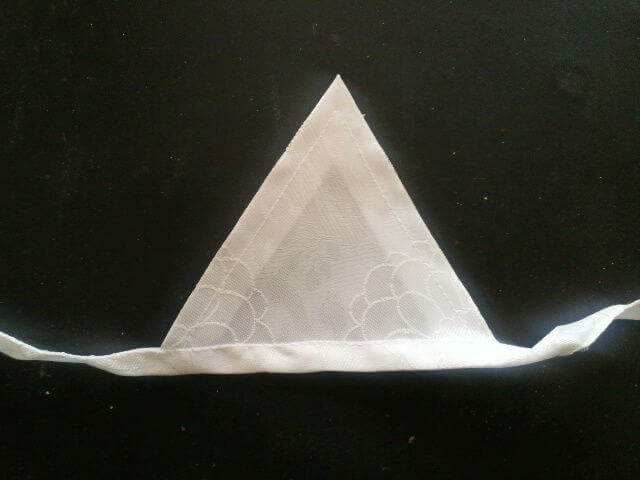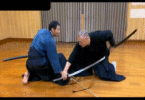Hi everyone how are you? Today’s subject is about quaint funeral that I experienced a couple of days ago in February 2019.
Before that, I’d like to inform you of another related blog “Funeral” from which you could get to know about the Japanese typical funeral as I wrote it in details and at the same time, I thank those who’s already visited.
What I surprised in attending the funeral, all of attendees are required to put a triangular white bandage on their forehead shown as the below image.
What’s quaint funeral ?
I reported it to put the triangular bandage on our forehead, but it’s hard in a way to express the appropriate word in describing it, say, we can account it a kind of celestial crown literally and/or a sort of bandana.
Seen as the photo here,
There are strings with the triangular white cloth and we fasten the strings in the back of our head so as not to fall.
Can you guess, however, why such a thing can be required on the occasion of the funeral?
That’s because this is used for custom to put on the forehead of the deceased person, and at the same time whose body is all covered by white, such as white kimono, white socks, white bag and so on by the Buddhist conventional custom.
But here in the funerals, I understood that there are such a rare, unique, and quaint custom still left and this is the first time to experience in my 72-year life.
Talking of the triangular white bandage, it reminds me of that Obake (ghost) always wear it on their forehead.
What’s Obake?
Have you ever seen Obake (ghost/spook) with the triangular bandage in the cartoons or comic magazines so far?
These Obakes are a class of “Yokai“, preternatural creatures in Japanese folklore. Literally, the terms mean a thing that changes, referring to a state of transformation or shapeshifting.
For further story about “Yokai,” please click here, thanks
Yokais are often translated as ghost, but primarily they refer to living things or supernatural beings who have taken on a temporary transformation, and these obakes are distinct from the spirits of the dead.
The obake usually either disguises itself as a human or appears in a strange or terrifying form such as a “hitotsume-kozō”, “an ōnyūdō”, or a “noppera-bō“.
In common usage, any bizarre apparition can be referred to as the obake whether or not it is believed to have some other form, making the terms roughly synonymous with yōkai.
According to the Japanese folklore, we have many other figures similar to Obake, but there is a little difference, such as “Bōrei” meaning ruined or departed spirit, “Shiryō” meaning dead spirit and “Ikiryō” which is not a form of ghost, but a living ghost or living creatures possessed by extraordinary jealousy or rage.
This is the scariest figure among them is “Yurei“.
What’s “Yurei”?
According to traditional Japanese beliefs, all humans have a spirit or soul called a “reikon“. When a person dies, the reikon leaves the body and enters a form of purgatory, where it waits for the proper funeral and post-funeral rites to be performed so that it may join its ancestors.
If this is done correctly, the reikon is believed to be a protector of the living family and to return yearly in August during the Obon Festival to receive thanks.
However, if the person dies in a sudden or violent manner such as murder or suicide, if the proper rites have not been performed, or if they are influenced by powerful emotions such as a desire for revenge, love, jealousy, hatred or sorrow, the reikon is thought to transform into the yūrei, which can then bridge the gap back to the physical world.
The emotion or thought need not be particularly strong or driving, and even innocuous thoughts can cause a death to become disturbed. Once a thought enters the mind of a dying person, their Yūrei will come back to complete the action last thought of before returning to the cycle of reincarnation.
The yūrei then exists on Earth until it can be laid to rest, either by performing the missing rituals, or resolving the emotional conflict that still ties it to the physical plane. If the rituals are not completed or the conflict left unresolved, the yūrei will persist in its haunting.
Oftentimes the lower the social rank of the person who died violently or who was treated harshly during life, the more powerful as the yūrei they would return.
This is illustrated in the fate of Oiwa in the story Yotsuya Kaidan
When they appear us, Yūrei are usually dressed in white, signifying the white burial kimono used in funeral rituals. In Shinto, white is a color of ritual purity, traditionally reserved for priests and the dead.
They sometimes have a “Tengan” or “Hitaikakushi” (literally “celestial crown” or “forehead cover”), which is a small white triangular piece of cloth tied around the head.
In short, Yurei is the ghost of a deceased human being, a phantom who haunt before our eyes which brings us the most dreadful blood-curdling.
Finally, I learned the rare, unique, and quaint custom of wearing the triangular white bandage tied around the head while a priest chanting a sutra.














